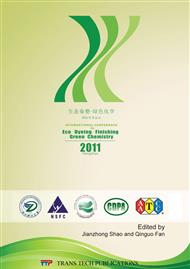p.619
p.625
p.631
p.636
p.640
p.645
p.651
p.656
p.661
Research on Detecting Tris-(2,3-dibromopropyl)-Phosphate in Textiles with the HPLC/DAD Method
Abstract:
A detecting method for toxic flame retardant finishing agent tris-(2,3-dibromopropyl) -phosphate (TRIS for short) in textiles was studied. In the method, an acetonitrile ultrasound-assisted extraction process was included in sample pre-treatment, and HPLC/DAD was used in the separation and identification of extractives. After that, the conditions of pre-treatment and chromatograph were optimized. The results showed that the limit of detection (LOD) by this method (S/N10) is 1.0 mg/kg, its recovery ranged from 78.1% to 98.4%, and RSD of the precision test is 3.2%, of which all met the requirements for routine testing.
Info:
Periodical:
Pages:
640-644
Citation:
Online since:
January 2012
Authors:
Price:
Сopyright:
© 2012 Trans Tech Publications Ltd. All Rights Reserved
Share:
Citation:


